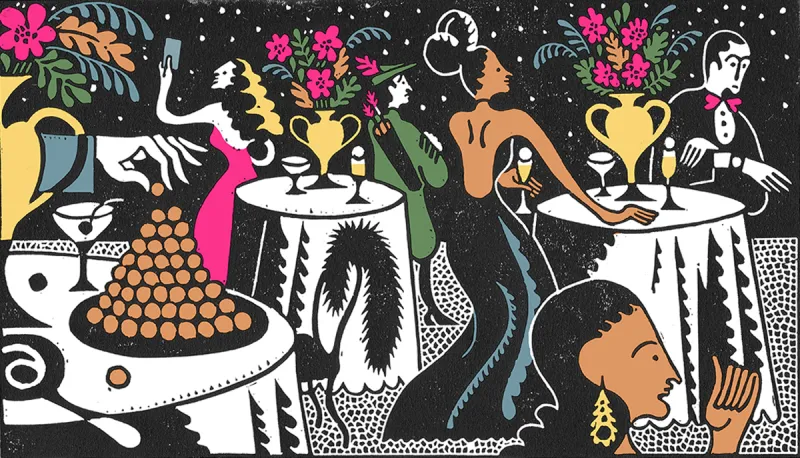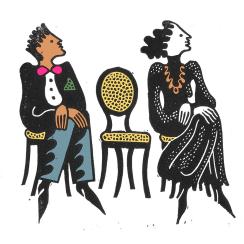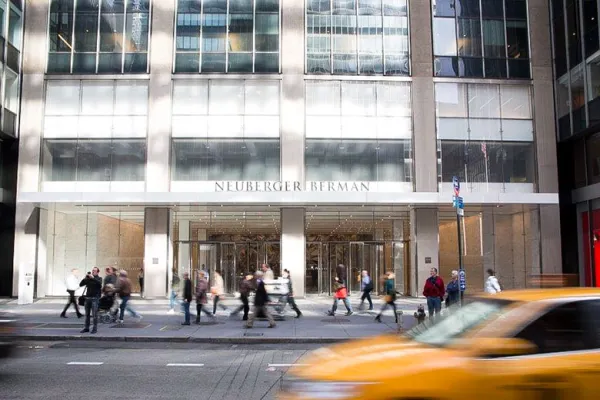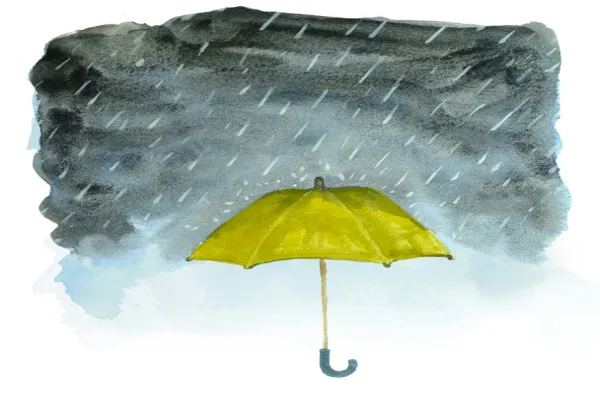
Illustrations by Sophy Hollington
It was the world’s most profitable striptease.
On May 14, 2018, hedge fund titan Paul Tudor Jones took the main stage at the Robin Hood Foundation’s 30th-anniversary gala at New York’s vast Javits Center, the only venue in Manhattan large enough to accommodate 4,000 members of the city elite. Wearing black tie and glittering gowns, they surrounded Jones, the foundation’s now 64-year-old co-founder.
He proceeded to rip off his business suit, Magic Mike–style. Underneath, Jones revealed a full Robin Hood getup, feathered cap and tights included, to the delight of his audience.
Then he turned the screws.
If the Robin Hood Foundation is infamous for any one thing, it is Jones’s annual ritual at this exclusive gala, when he shakes down his fellow billionaires for $1 million pledges. “You can do this,” urged Jones. “Those of you who are a little shy about raising your hand, just nod your head at me. It’s not my first rodeo.”
Jones whipped up momentum while an auctioneer kept count of the million-dollar donations. “I have one. Thank you. I have two. I have two. I have three. Thank you, young lady.” Donors — many of them spontaneous — appeared on the ballroom Jumbotrons, where their colleagues, rivals, lovers, and idols would surely spot them. It was utterly absorbing. “I have 12. I have 13 in the very back. I have 14. Ladies and gentlemen, it’d be great to get to 20 . . .” But Robin Hood maxed out at 15.
Celebrities bring the glamour, Wall Street the money to the annual extravaganza. Oprah showed up this time, along with Robin Hood board member Katie Couric, Eli Manning, Bill Gates, and Jennifer Lopez — her beau, A-Rod, in tow. Couric mixed and glad-handed, while hedge fund manager Bill Ackman stood alone at the bar. Both could have been anywhere else that evening — Ackman seemed to want to be — yet Robin Hood pulls them in, year after year.
Jones set up Robin Hood with a few friends in his Manhattan bachelor pad in 1988, and continues to serve on the board. Since 1988 the nonprofit has raised and spent about $3 billion to fight poverty in New York City. Robin Hood has become the charity of choice for the hedge fund class.
As with Jones’s game of $1 million one-upmanship, the foundation has over the years honed its formula for squeezing the rich and aiding the poor. The key tenet: metrics. Robin Hood pioneered the quantification of philanthropy. It’s not enough to say you’ve done good with donor dollars. Investors want to see the numbers, and Robin Hood earned their fierce loyalty by letting them do just that. “We didn’t know that we’d be emulated by hundreds of other charities and foundations and individuals, here in this country and around the globe,” Jones told the audience in May. “That’s Robin Hood’s greatest achievement.”
Before J. Lo kicked off a private show, regular attendees were anticipating the gala’s usual climax: Jones unveiling the night’s total fundraising take. It was $54.5 million in 2017 and a staggering $73.5 million in crisis-wracked 2009. This one-night figure had become shorthand for attendees’ and Robin Hood’s success for the year, despite the foundation’s goal of alleviating poverty, not gathering assets. Then last May the narrative changed.
“Everyone’s going to talk tomorrow about how much money we raised. To hell with that!” Jones declared from the stage. “How many miracles have we done? How many lives and destinies have we altered together for the betterment of those folks forever?”
Officials say gala donations rose from 2017, but still refuse to disclose an actual figure. This is very much intentional. For perhaps the first time, the Robin Hood Foundation — a brand imitated by peers and studied in business schools — wants to be something else.
For decades, Robin Hood has thrived on its formula of powerhouse fundraisers, disciplined budgets, hedge fund megadonors, and ruthless cost-benefit analysis. The mission of eradicating poverty in New York City hasn’t changed since 1988. And until two years ago, nor had the organization’s day-to-day leader.
Co-founder David Saltzman agreed to run Robin Hood in its infancy, and stayed for 27 years. “Paul Jones and Peter Borish, who was working at Tudor Investment Corporation at the time, predicted that markets were going to crash in 1987,” says Saltzman, remembering the moment of creation. “And as a result, they and Tudor’s investors made a tremendous amount of money. But Paul and Peter felt that the stock market crash was going to be the beginning of a very, very tough time for poor people.” Jones invited Borish, Saltzman, future hedge fund manager Glenn Dubin, and a friend he’d met volunteering over to his bachelor pad near the United Nations to talk things over. Young and rich, Jones felt a moral obligation to help the needy, with an urgency all five men shared.
“New York in 1987 and 1988 was a really scary place compared to today,” Saltzman says from his office in TriBeCa. It’s now one of the country’s most expensive neighborhoods — the sort of place where Robin Hood donors live and work. In 1985, however, the Times described TriBeCa as a group of “gritty warehouses” and warned archly, “Entertainment and nightlife below Canal Street are decidedly nontraditional.”
“We were in the middle of the AIDS epidemic,” says Saltzman, a lifelong New Yorker. “We were in the middle of the crack epidemic. The murder rate was a multiple of what it is today. Every young woman I knew walked clutching her keys like this” — thrust out of a balled fist, Wolverine-style. “It felt as though not only was it the right thing to come together and help our neighbors, it was something that we had no choice but to do.”
Jones suggested pooling resources, both financial and intellectual. That night, over Chinese takeout, the group of 20-something men decided to try to figure out the best way to fight local poverty. “I don’t think, at that time, anyone imagined that Robin Hood was going to grow much beyond the five of us,” Saltzman says. “There was no name, no office, no staff, no computer, no phone number. Just an idea.” And $52,000, granted that first year to two children’s charities that Robin Hood still supports.
“First and foremost, many of Robin Hood’s founders came from [the hedge fund] industry,” says board chair Larry Robbins, who leads Glenview Capital Management. “Obviously, Paul Tudor Jones and Glenn Dubin not only are iconic in the philanthropic world — but in the alternative-investment management industry, too. One of the great things that people can do in charitable endeavors is give not only resources and intellectual capital, but also their networks. Paul and Glen did a wonderful job of reaching out to people like Stan Druckenmiller or Lee Ainslie” — hedge fund billionaires — “and of attracting people who enjoyed meteoric personal professional success and were inspired philanthropically to make a difference.” Jones set Robin Hood up as a vehicle for his fast fortune and altruistic impulse (or winner’s guilt). A generation of hedge fund nouveaux riches embraced it the same way, Robbins explains. “The alternative-investment management industry — certainly with a fee structure that was prevalent 15 years ago — had the capacity to create immense and nearly immediate wealth in a more rapid time frame than almost any other industry.” Plus, investors like Jones made their money in cash.
It’s not clear that Jones, Saltzman, and the others recognized Robin Hood’s strategic position at inception. But either way, the nonprofit was in the right place at the right time — and no one capitalizes on market opportunity like hedge fund guys. “The best way to attract significant donors to a cause is to find people who currently aren’t committed to a cause,” says Robbins. “Generally speaking, that is identifying people who are on the way up before they’ve enjoyed their significant wealth creation and have already aligned themselves with different institutions. Since the hedge fund industry was a powerful engine for success stories, and paid annually in cash, that allowed for some significant and now lasting philanthropists to be created.”
The New York City region remains the hedge fund capital of world, but Robin Hood’s leash to the city has cost it donors and opportunities. When they move away, often so does their support. Why would Jones and his ambitious co-founders fence off just five boroughs of a needy world? Because it’s home, says Jones. The investment community loves Robin Hood because it’s tied to the city, he argues. “If you think of our earliest supporters — think Soros, think Robertson, and you could put me in that group — they came from somewhere else but had their financial success here in New York. So we wanted to give back to the place we called home,” Jones explains.

Those were busy years.
Moore had left the inner-city Baltimore of his early childhood for the Bronx in 1990, and then, a few years later, departed the Bronx for military school (not voluntarily). He went from a junior college to Johns Hopkins to Oxford University as a Rhodes Scholar. He left his first finance job to fight in Afghanistan. He’s been a paratrooper, a troop commander, a White House fellow, a Citigroup investment banker, and a New York Times best-selling author — twice. Moore got married, left his second finance job, had a family, and founded a tech company to help at-risk high school students transition to college. He agreed to advise on the Robin Hood Foundation’s initiative on veteran homelessness, which helped cut that population in New York City to virtually zero. In the process, Moore landed on the short list to become Robin Hood’s next CEO.
“We have a two-smart-person rule here at Glenview, which is that if we hear the same idea from two smart people, we generally drop everything and research it because there’s a chance it is a very smart idea,” says Larry Robbins, who runs a $16 billion hedge fund and co-chaired Robin Hood’s CEO search committee. “David Saltzman was one of the two smart people that recommended Wes. So that evening I went home and started doing Google searches on Wes, whom I did not know and — as a measure of the narrowness of my life — had not even heard of. I actually was up well into the night, and I think I spent 11 hours cyberstalking Wes. I watched almost every Ted Talk and YouTube interview, and read excerpts from his book.” Robbins admits, “I developed a bit of a man crush.”
He wasn’t the only one. Paul Tudor Jones, when asked about the selection process, responds, “Who wouldn’t want to hire a comet? His energy level’s so high — who wouldn’t want to hook themselves to a shooting star?”
Moore took a few more months to know he wanted Robin Hood as much as its board members wanted him. In early 2017, he remembers, “I got a chance to come up to New York and spend some time with a lot of family members. This is while I’m doing my own personal diligence process into the role. I’m very proud of the fact that I spent a good amount of my childhood here in the Bronx. And in fact, one of the communities that I lived in was one of the first communities that Robin Hood invested in. And taking this train ride, as I’m going through all the Robin Hood documents, it was almost like watching the evolution of Robin Hood’s impact on poverty right before your eyes. But you also see that the problem is not getting smaller fast enough.”
In New York City one in five people lives in poverty. This number hasn’t improved since at least 2005, when the city’s current count began. The city’s poverty line for individuals is sub-$11,722 per year in income and below $23,497 for a family of four. A typical one-bedroom apartment in the South Bronx rents for about $1,500 per month, or $18,000 a year, according to median figures from data aggregator Zumper.
But the one-in-five figure fails to capture the huge liminal population, as a joint Robin Hood–Columbia University data project discovered. One in five adult New Yorkers lives in poverty, but nearly one in three experiences it during a given year. Moore calls this dynamic “fascinating” and the research a hallmark success. “For a little less than half the people who are living in poverty, theirs is a concentrated, predictable, generational poverty,” he explains. “For the rest poverty is much more fluid. They’re consistently falling in and out. They’re so close to the line that a single shock is enough to knock them right back down into poverty. A child getting sick. Missing a train and showing up late. Going to the doctor for a couple of hours — that can mean your job. A price hike in transportation. Robin Hood understands that poverty is not a siloed conversation. When people say, ‘Well, how do you help move a person out of poverty? Is it education? Or is it housing? Is it transportation? Is it justice reform? Or is it mental health?’ Often, when you’re talking about poverty, the answer is yes.”
Tackling each factor, even with exacting cost-benefit metrics, requires an army of $1 million donors. But there aren’t enough hedge fund managers in existence — which is the plight facing Robin Hood’s new leaders. “There are two sides to Robin Hood,” says impact investing pioneer Mark Kramer. “My understanding is that the hedge fund industry, while it has been immensely effective in creating wealth for some practitioners, has not been so successful in the past decade. A major question right now is to what extent can Robin Hood really diversify its fundraising beyond hedge funds into the broader realm?”
Robin Hood is zero for one in its sole previous attempt to transition power. The years-long episode stands out as a notable failure of Saltzman’s 27-year-tenure, and a departure from a largely stellar track record.
In 2011, Robin Hood hired Deborah Winshel as chief operating officer, and 12 months later promoted her to be its first-ever president, as well as COO. This was a period of rapid growth that compelled the organization to build out its one-man-leadership band. On paper, Winshel looked like Saltzman’s missing half. In practice they clashed, according to two sources familiar with the situation and Glassdoor reviews posted at the time. “I can understand why it made sense for Deborah to have joined,” one source says. “She had a different skill set” and background than Saltzman, including a long tenure at J.P. Morgan and eight years as CFO of the Metropolitan Museum of Art. However, “it just didn’t work out.” Saltzman refused to give up meaningful control to Winshel, whom the board appointed as his partner but the co-founder treated as a threat. Tension between the pair spilled beyond the C-suite, Glassdoor reviewers complained and insiders verified. “Staff is divided between the two leaders,” one wrote in mid-2014. “The battle must be decided.”
By 2015 it was. Winshel left for BlackRock, whose CEO, Larry Fink, served at the time on Robin Hood’s board. She is now global head of social impact there and, like Saltzman, declined to comment on the episode. But Winshel’s “very bumpy” tenure “broke a lock on the organization,” one source says. She’d joined an “old-boys club” that revolved around a single individual, and left behind a substantially diversified staff and a wizened board.
Perhaps chastened, Robin Hood’s board and CEO search committee went for a high-conviction handover the next time around — no half measures.
The leadership team of today looks radically different from the steady group of Saltzman’s era. Moore became Robin Hood’s inaugural CEO in 2017; Robbins took over the 41-person board as chair; and media executive Derek Ferguson has just finished his first year as COO. “I’m proud of the fact that in the last two years, Robin Hood has gone through a fairly significant leadership change and board revamp,” Robbins asserts. The top brass had for years looked more like a hedge fund conference than the communities it serves, and that’s changing, he points out. He doesn’t skate on the challenges they’re working through — or trying to.
“The hedge fund industry is very well compensated, and if you give as much as you can during good years, that means you didn’t create a reserve for challenging years,” Robbins explains. (His firm, Glenview Capital Management, had such a year in 2015, and offered investors a zero-fee side vehicle. Glenview promptly delivered a dramatic 23 percent comeback in 2017. Robbins returned to II’s Rich List at No. 23, earning an estimated $230 million purely from returns on his own invested capital.)
Many of Robin Hood’s peer foundations likewise spend $100 million to $200 million a year — without which people literally go hungry — supporting critical causes, but have $1 billion or more stashed away, kicking off investment income and allowing them to bridge occasional shortfalls. The New York City–based Rockefeller Foundation, for example, in 2016 gave out $173 million and finished the year with $4.1 billion. Robin Hood granted $133 million, to end with $315 million. It has minimal reserves by design. Every dollar Paul Tudor Jones earns stripping onstage is a dollar spent renovating a KIPP charter school in Brooklyn or feeding an infant in East Harlem. Robin Hood’s board of investment titans covers 100 percent of the foundation’s overhead, which plays very well with donors and nonprofit ranking models like Charity Navigator. But just as with hedge funds, there’s no cushion or coasting.
Beyond Robin Hood’s short-term funding volatility, “there are several factors that do challenge the revenue model,” Robbins says, diving into fundamental analysis as he might for a stock. “There’s no question that hedge fund fees have compressed and that hedge fund returns have compressed. That pressures the core support base of Robin Hood. We’ve also seen certain hedge fund managers become so successful that they’ve created family offices and are now investing directly — which is again a wonderful high-class problem. But nonetheless, it means that Robin Hood needs to find other funding sources. To the extent that Steven A. Cohen or Stan Druckenmiller are investing significant sums of money in adjacencies to Robin Hood — while that doesn’t go through Robin Hood’s income statement or balance sheet — it certainly is a wonderful outcome for the world.”
And yet. Even when Robbins took zero fees from investors, one can be certain he’d have preferred that Glenview had delivered them that 23 percent, not Elliott Management or Third Point. In Robin Hood’s case, everyone involved seems to fiercely believe in the nonprofit’s edge in fighting local poverty. But the stakes for an unambitious, placid Robin Hood are even higher in stakeholders’ eyes. The marginal $1 million that Jones fails to arouse, or a megafinancier’s fortune that’s diverted to a family office, or a tech unicorn founder who brushes Robin Hood off as a “hedge fund charity” — that money likely doesn’t go to feeding the elderly or graduating driven young poor people from community college. It often goes to Harvard, or the Met, or an account in the Cayman Islands.
Even Kramer credits the nonprofit for its oft-overlooked mission. “It’s an interesting picture to think about the wealthiest people on the planet working to help the poorest in the city,” muses the Harvard Business School lecturer and co-founder of FSG, which advises nonprofits. “The fact it’s focused on poverty alleviation is a good and noble thing. It’s not a given that these hedge fund guys would be giving money to help the poor, as opposed to the opera or their university. I think there’s a lot that Robin Hood does right.”
Most decent investors would give the same answer as Robbins: “Robin Hood does need to broaden out its funding base to find the next series of donors who are willing to not only replace those dollars that have graduated, so to speak, but also can expand the power of Robin Hood and the impact of the work,” he says.
Wes Moore, when he was elbow-deep in due diligence on that Bronx-bound train, certainly recognized Robin Hood’s variable contributions and the brand’s unusual emphasis on those figures: $134 million in 2017, $136 million in 2016, $181 million in 2015, $175 million in 2014, $147 million in 2013. The same critique that investors make about some hedge funds might apply to Robin Hood’s past PR strategy: too much emphasis on fundraising, not enough on results.
In searching for a CEO, Robbins and Saltzman recognized the gift of life as well as the real handicap a hedge fund birth gave the Robin Hood Foundation. They chose Moore, a man fluent in finance who nonetheless dropped it at the call to service. Leading Robin Hood means living in the far left and right tails of New York City society, engaging the very poorest and the absurdly rich. Success means infiltrating and winning over unfamiliar territory beyond the hedge fund bosom. How does he reconcile it all?
Moore replies, “I’ve lived my whole life that way.”





